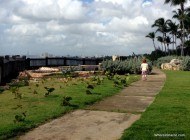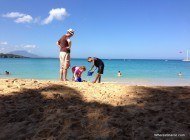Ever since booking our tickets to the Dominican Republic, we had been discussing whether to visit Haiti or not.
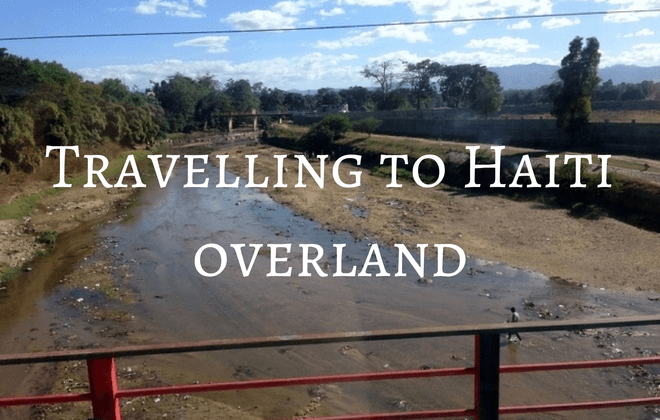
Massacre River on the border
Sharon and I are natural explorers and the temptation to visit another country when it is only a few hours away is strong. However, there are many warnings for Haiti. There are security, violent crime and health concerns. In fact, any concern you can think of is probably listed in the government advisory warnings for Haiti. For this reason, we couldn’t take the kids to Haiti. We were both curious though so, after a lot of research, we decided I would head over to the safer and closer Cap-Haitien for a few days to visit the UNESCO listed Citadel and Sans Souci Palace. I was looking forward to the adventure! But first, I had to get there.
Contents
Getting to Haiti from Cabarete, Dominican Republic
There are many ways to get to Haiti from the Northern coast of the Dominican Republic. It is possible, but time consuming and uncomfortable, to take the local vans, guaguas the whole way. I decided to catch a nice big bus from Santiago direct to Cap-Haitien, my final destination in Haiti instead. This bus would supposedly take me across the Haiti Dominican Republic border and make everything easier and smoother.
Step one: Cabarete to Sosua to Santiago, Dominican Republic
There is just one of the direct Haiti buses a day from Santiago and I wanted to make sure I was on it. I left Cabarete for Santiago early. This journey involved catching a guagua from Cabarete to the next town, Sosua, in time for the first bus to Santiago at 8:20am. This took me to Santiago’s main Caribe Tours terminal, Las Colinas.
Step two: Buying a bus ticket to Cap-Haitien
The Las Colinas terminal is the larger of Caribe’s two terminals in Santiago and is in the north of the city. The bus to Cap-Haitien leaves from here. The terminal has some useful facilities, such as an exchange bureau (with better rates than around Cabarete), a reasonably stocked food outlet and a heavily air conditioned seating area. Tickets for the bus to Haiti are sold from a small office on the side of the terminal, facing where the buses park, with a small sign saying “Ruta Internacional.”
I knocked on the door, and entered. The man behind the desk spoke English as well as Spanish without issue. He explained the costs, which I asked for in both US dollars and Dominican pesos. A return ticket was $50 US or 2100 pesos. In addition to that there was $25 – payable in USD only – for entry and exit fees. I asked if this covered both ways and was told it did. However it did not, and more money was required on the way back.
I had to nominate the dates for both legs of the journey and the tickets were valid only for those days. I elected to pay for the ticket in pesos, being slightly cheaper and received tickets for both legs of the journey. I was asked for my passport, the details were recorded, and I was told I would see it again at the border.
I could have, in theory, booked a ticket on the Caribe Tours website. However it didn’t work for me, and other people online seemed to have the same issue. Getting a ticket in person was the only way.
Step three: Catching the bus to the Haiti Dominican Republic border
The bus arrived shortly after 11:30am, and we were allowed to board around 11:45. I had no luggage except my small backpack but bags could be checked in under the bus, with a receipt given by the porter. The bus was a reasonably modern coach, with comfortable reclining seats, A/C and a toilet (that flushed but had no water for the basin). Shortly after boarding we received a warm Creole style meal of rice, beans and some chicken in a sauce and a salad plus a cold bottle of water. Most people ate the meal before we left and the rubbish was swiftly collected.
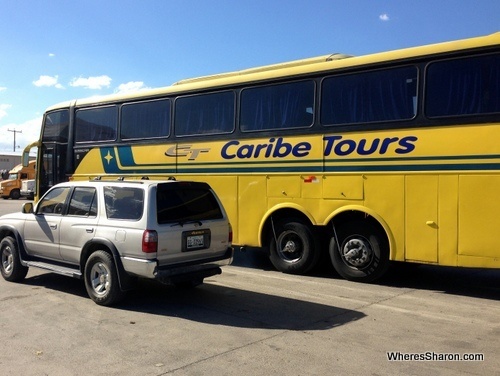
My bus
The bus departed at 12:15pm, a quarter of an hour late. We were given a Dominican entry/exit form to fill in as we left. I studied my fellow passengers; most were Haitians returning home, there were a couple of other Westerners. It didn’t seem like there were any Dominicans aside from the driver.
Shortly after we left Santiago the conductor put on a movie. It was weirdly in English. It was made in a nearby Caribbean country and was an awful religious themed piece of rubbish with atrocious dialogue and bible thumping exorcisms. Being in English, it was harder to ignore. I envied everyone else on the bus that didn’t speak English.
It took two hours to reach the border and the movie ran almost the entire time.
Step four: Crossing the Haiti Dominican Republic border
We drove through Dajabon, the town on the Dominican side of the crossing, to the customs and immigration compound. The bus was parked to the side of the large building and, awaiting its doors to open, were the usual collection of beggars and money changers that seem to be at every border crossing anywhere. We sat on the bus for a few minutes as the conductor got off, then got back on and gave most of us our passports and sent us off to get stamped.
Some people’s passports were kept by the conductor for some reason. She took these personally to the immigration office where they were stamped. The rest of us had to wait in line, although not very long, to get our forms taken and our passports stamped. My passport was stamped and given back to me to hold onto for the next stage. No money was needed. All up it was roughly 45 minutes between the time we arrived and left.
The Haiti Dominican Republic border itself is heavily secured. The road is lined with fences and razor wire and each side of the bridge we crossed had a gate. The bridge itself wasn’t too large and the Massacre River (named after the “parsley” massacres that occurred there in the 30s) was little more than a wide but shallow creek, with the Haitian side strewn with a lot of rubbish.
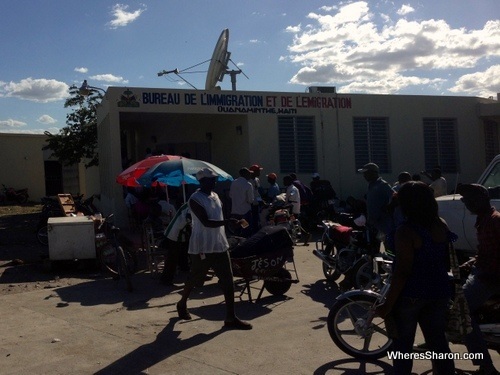
The Haitian border post
The Haitian border post was smaller and more relaxed than its Dominican counterpart. We all filed off the bus, were identified by the conductor as being bus passengers (she’d again gone into the office), handed over our passports to the policeman sitting at the desk (everyone had been given their passport this time), who stamped it and put it to the side. We all got our passports back once on the bus. Again we weren’t required to pay any money, just get stamped in. Even if you spoke no Spanish or French/Creole it was all easy to understand what to do.
The post itself was almost communal except for the police in the office. People not going anywhere sat inside the cool building talking, charging phones or doing business. There were some nice toilets.
Step five: Changing money at the Haiti Dominican Republic border
I changed a few thousand Dominican Pesos into Haitian Goudes. I had looked up the exchange rate and it was 1 peso to 1.03 goudes at the interbank rate. I was surprised when I received the very fair rate of 1:1 and got back crisp new notes in return for my worn pesos. I spoke basic French to them but they explained everything in what English they had, and they used their phone to make sure I knew what I was getting. They were polite and friendly and much better than money changers I’d deal with in Cap-Haitien.
All in all the Haitian border formalities took just 15 minutes. There were no customs checks. I didn’t notice at the time, but between the first Sunday in November and the second Sunday in March Haiti is in a different time zone, UTC-5, to the Dominican Republic and so I gained an hour crossing the river. The rest of the year Haiti has daylight savings and is UTC-4, the same as in the Domican Republic.
Step 6: Travelling onwards to Cap-Haitien
As we left the border crossing the conductor put on another movie. It was a Haitian film and seemed to involve scenes of at least two people shouting at each other the entire time. It was just over an hour and a half to the outskirts at Cap-Haitien. The Caribe Tours terminal is just north of the main part of the city, on the corners of Rue A and Rue 29. We pulled in around 4:30pm, for a complete journey time of roughly 5 hours, 15 minutes.

The Caribe Tours terminal in Cap-Haitien, on Rue 29.
The walk into the main part of town was about 10 minutes. Another 15 minutes would be needed to get to the main tap-tap (local transportation) departure point further south.
Read my first impressions of Haiti and things to do in Cap-Haitien.
Catching the bus back to the Domincan Republic from Haiti
Buses from Cap-Haitien to Santiago depart daily at 8am. Existing tickets are meant to be confirmed at least half an hour before, so I arrived around 7am, keen to get going.
There is a small ticket office at the terminal, and there was already a queue when I arrived so I decided to join onto the end. Again, most of the passengers seemed to be Haitian; curiously, most had US passports. When I arrived at the front, I was told I needed to pay a further $30 US for border fees (Update April 2015: recent reports have the fee at $20 US. Maybe I was ripped off…). I tried to protest that I’d already paid but my paltry French was no good. I had noticed everyone else in front seeming to pay the same amount as well so there seemed nothing for it but to pay up.
I slid my passport across with the money, and my ticket was scribbled on and I was sent on my way. There’s little to do at the terminal waiting for the bus to go, although at least there was a toilet. There were some seats but the bus looked like it would be close to full so they were all taken.
The bus was slightly nicer than the first one I took. Just after 8am we were allowed to board, the conductor going through each passport and called out the name. Just after we got on, we were given a small cheese and ham roll, a cup of orange juice and a bottle of cold water. We were on our way about 8:10am.
Crossing the Haiti Dominican Republic border in reverse
Getting through the two border posts took much longer than the first time. On the Haitian side at Ouanaminthe, we were given our passports before getting off the bus and lining up to be stamped out at the same window. Our passports were kept again.
I took the opportunity to change my remaining gourdes into pesos, and I was surprised to be offered the rate of 1 for 1 again. Maybe the exchange rate had moved but I am not sure how they made their money otherwise.
The bus had far more people than on the way over, so it took 40 minutes before we were finished on the Haitian side. The checkpoint itself also seemed busier in general.
Things took much longer on the Dominican side. We were given our passports just before getting off the bus again, and went to join an already long queue at the arrivals window. Arrivals were taking much longer than departures, although for people off the bus, without the need to pay for an entry stamp, it was much faster. This caused a few Haitians that weren’t on the bus to push into the line, in the hopes of sneaking through faster (it didn’t work) which blew the line out longer.
Once our passports were stamped and given back to us, I returned to the bus. It was locked, except for the luggage section underneath and I was directed to grab my luggage and join the queue for customs clearance which was really just a large room with a table. There were no customs officials, just a lot of Haitian shoe cleaning kids who had to be chased out before anything could happen. Once there were enough people in the room a customs officer decided to start.
For the obvious tourists or those with little bags, the customs check was a mere feeling of the bag and maybe a quick look to check for whatever. Haitians, who had a lot more luggage, had to open their bags for a more thorough inspection. For individuals crossing the border there is a customs window next to the entry window where bags are checked. There is no need to go to the hall and wait. Once people had started going through customs the bus was opened again so we could get out of the heat.
We stopped for nearly 80 minutes on the Dominican side of the border. All up we spent more than two hours at both sides of the Haiti Dominican Republic border combined. From there, it was just over two hours to Santiago. We arrived back there right on 3:00pm, for a total travel time of 5 hours, 50 minutes.
Thanks to readers D & KE for their comments and corrections to help keep this article up to date. Please let us know in the comments if you’ve done the same journey and have anything to add or correct.
Would you visit Haiti if you were in the Dominican Republic?
Tags: Dominican Republic Travel Blog Haiti Travel Blog








